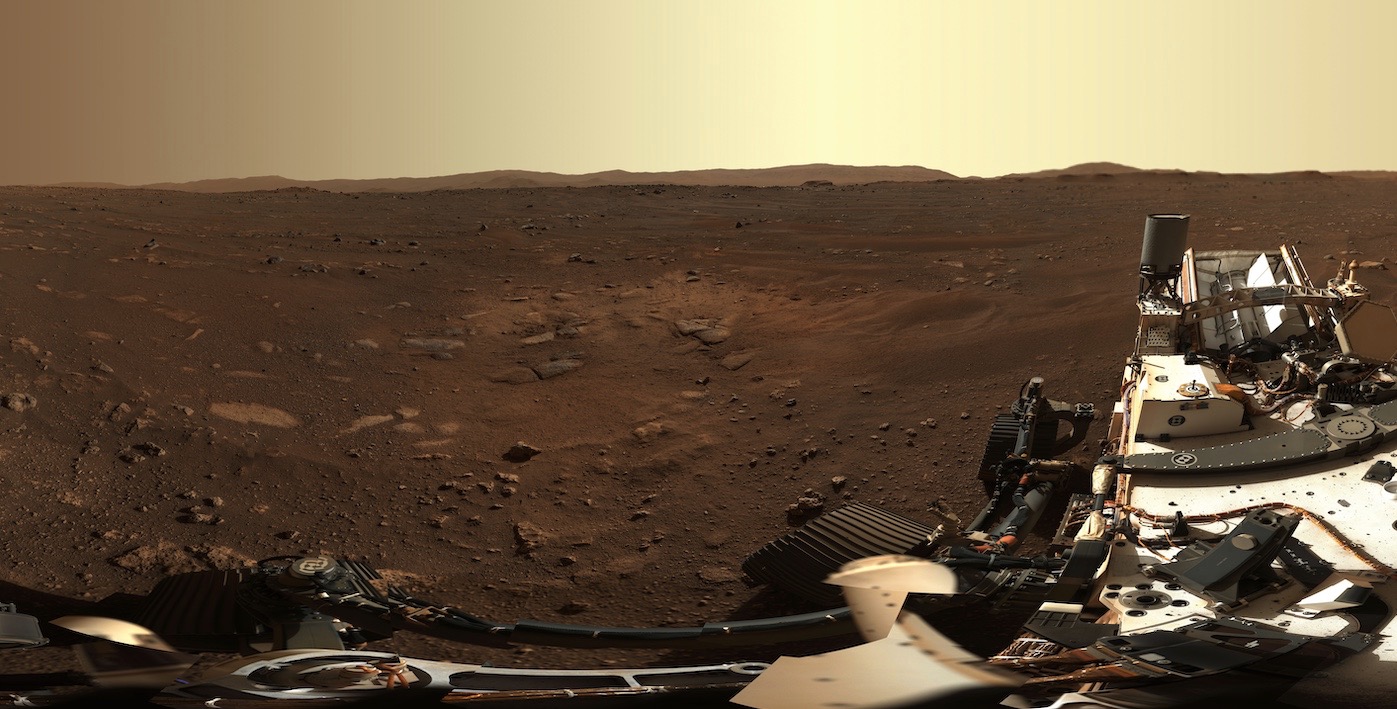Update for Thursday, Feb. 25: NASA is holding a press conference to showcase the Perseverance rover's first panorama. Watch it live above.
NASA's Perseverance rover has given us our best view yet of its Martian landing site.
The car-sized Perseverance captured a gorgeous 360-degree panorama of its surroundings on the floor of Jezero Crater, which harbored a lake and a river delta billions of years ago.
The photo, which NASA released today (Feb. 24), is composed of 142 individual images taken by Perseverance's Mastcam-Z camera system on Saturday (Feb. 21), three days after the rover touched down.
Related: Where to find the Perseverance rover's latest Mars photos
Live updates: NASA's Perseverance Mars rover mission

You can download the Perseverance's full HD panorama of its Mars landing site from NASA here.
Mission team members had already stitched together a Jezero panorama using images taken on Friday (Feb. 20) by Perseverance's navigation cameras. But the high-definition Mastcam-Z has sharper eyes, so the newly unveiled photo is more striking and detailed.
Jezero's distant rim is visible in the new photo, as is a cliff face that's a remnant of the ancient delta, NASA officials said. The new panorama is zoomable, so you can inspect those features — and others in the foreground, including curiously "holey" rocks — up close in the full-resolution version, which you can find here.
Get the Space.com Newsletter
Breaking space news, the latest updates on rocket launches, skywatching events and more!

As its name suggests, Mastcam-Z sits on Perseverance's headlike mast. The system consists of two zoomable cameras that can resolve features as small as 0.1 to 0.2 inches (3 to 5 millimeters) across close to the rover and 6.5 to 10 feet across (2 to 3 meters) in the distance, NASA officials said.
Mastcam-Z is similar to the Mastcam system on Perserverance's predecessor, the Curiosity rover, which touched down inside Mars' Gale Crater in August 2012 and is still going strong. But Mastcam-Z is more capable. For example, Curiosity's Mastcam can't zoom, which you may have guessed from the lack of a "Z" in its name.
Related: NASA's Perseverance rover Mars mission in pictures

The Perseverance team is just starting to take stock of the landing site. But the rover's early photos show a landscape that looks similar to those explored by other NASA Mars rovers.
"We're nestled right in a sweet spot, where you can see different features similar in many ways to features found by Spirit, Opportunity and Curiosity at their landing sites," Mastcam-Z principal investigator Jim Bell, of Arizona State University’s School of Earth and Space Exploration, said in a NASA statement.
NASA will hold a question-and-answer session tomorrow (Feb. 25) at 4 p.m. EST (2100 GMT) to discuss the high-definition panorama in detail. Bell will participate in that event, as will fellow Mastcam-Z team members Elsa Jensen, of Malin Space Science Systems, and Kjartan Kinch, of the Niels Bohr Institute of the University of Copenhagen in Denmark. You can watch the briefing live here at Space.com, courtesy of NASA.
Perseverance is the heart of NASA's $2.7 billion Mars 2020 mission, which will seek signs of ancient Mars life in Jezero and collect dozens of samples for future return to Earth. The rover also carries several technology demonstrations, including a helicopter named Ingenuity that will attempt to become the first rotorcraft ever to fly on a world beyond Earth.
After finishing Perseverance's post-landing health checkouts, the rover team will gear up for Ingenuity's pioneering flights, which will likely take place this spring. The science and sampling work will probably begin in earnest this summer, if all goes according to plan, mission team members have said.
Mike Wall is the author of "Out There" (Grand Central Publishing, 2018; illustrated by Karl Tate), a book about the search for alien life. Follow him on Twitter @michaeldwall. Follow us on Twitter @Spacedotcom or Facebook.
Join our Space Forums to keep talking space on the latest missions, night sky and more! And if you have a news tip, correction or comment, let us know at: community@space.com.

Michael Wall is a Senior Space Writer with Space.com and joined the team in 2010. He primarily covers exoplanets, spaceflight and military space, but has been known to dabble in the space art beat. His book about the search for alien life, "Out There," was published on Nov. 13, 2018. Before becoming a science writer, Michael worked as a herpetologist and wildlife biologist. He has a Ph.D. in evolutionary biology from the University of Sydney, Australia, a bachelor's degree from the University of Arizona, and a graduate certificate in science writing from the University of California, Santa Cruz. To find out what his latest project is, you can follow Michael on Twitter.









